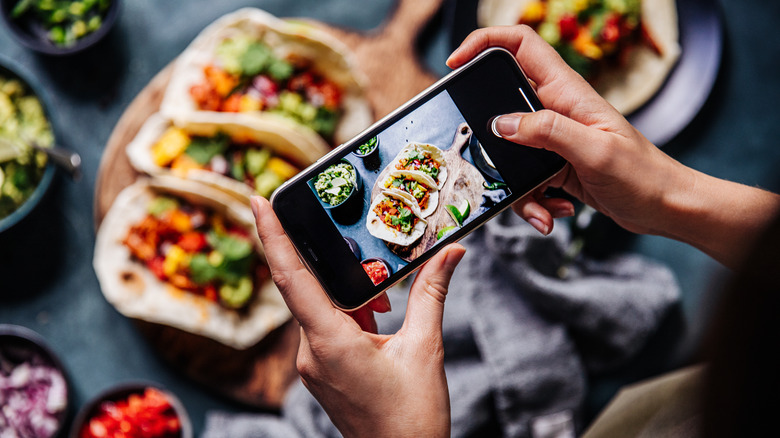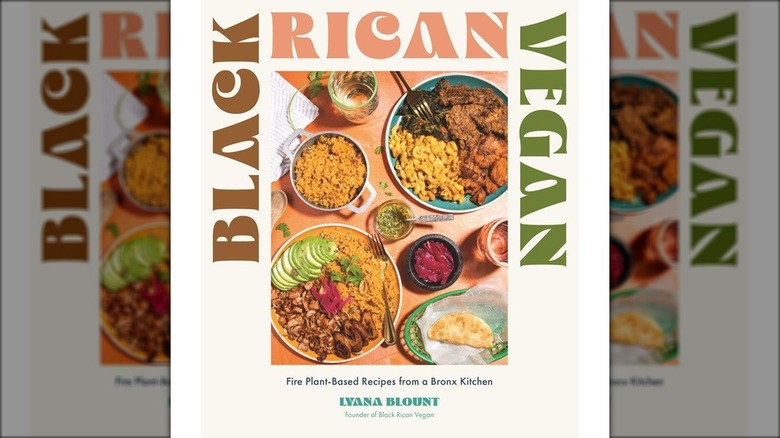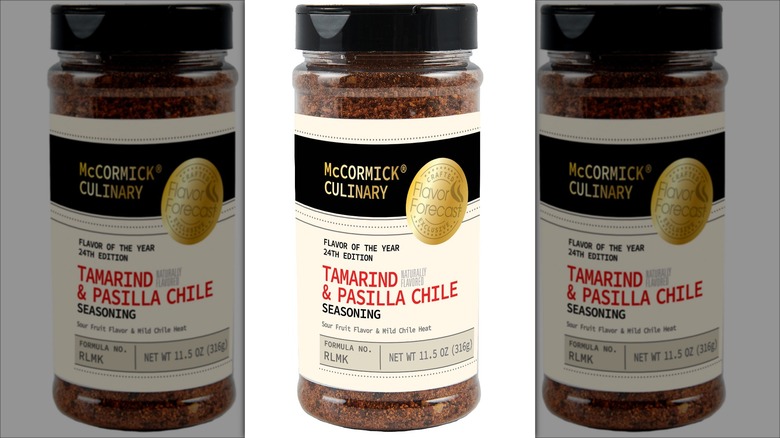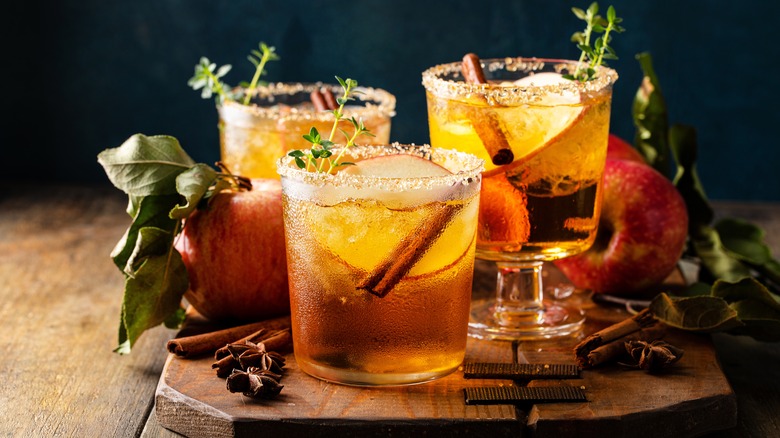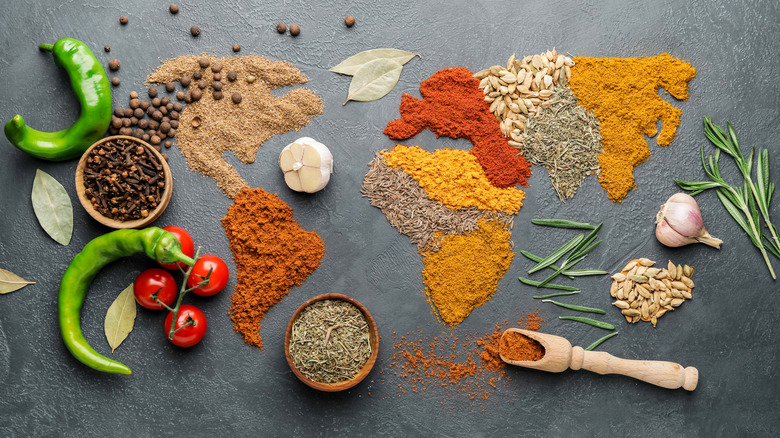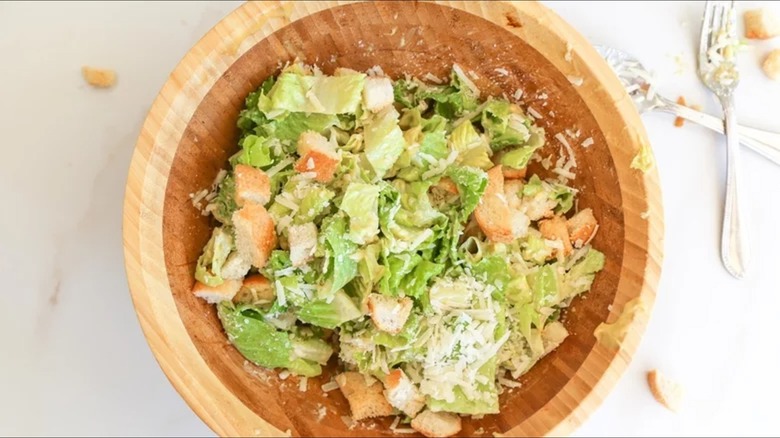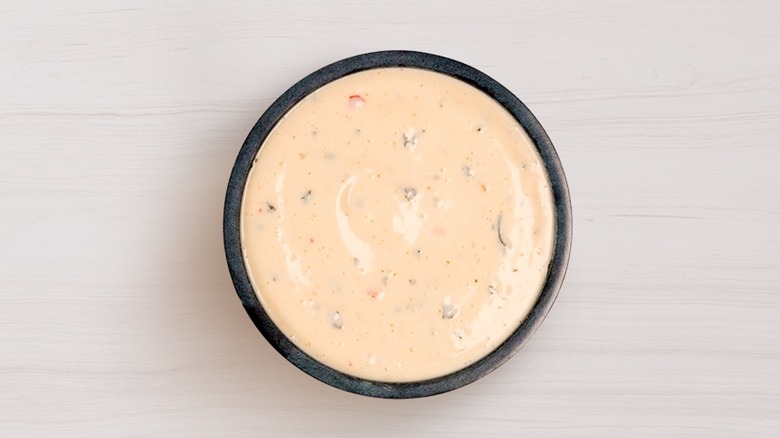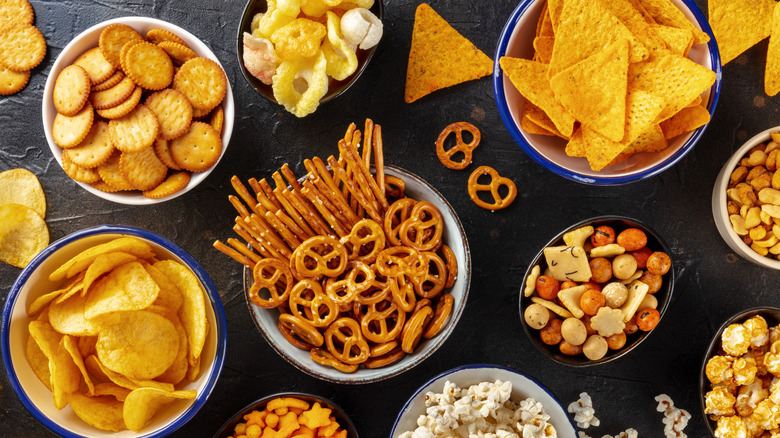Food Trends That Are Going To Take Over 2024
While we don't have a crystal ball to show us the future, we still have a good idea about which food trends are likely to take hold in 2024. Emerging statistics and educated guesses point the way toward what we can expect to see as the year unfolds. However, sometimes it's impossible to predict the weird trends like lemon coffee or the cottage cheese and mustard diet you should have put on last year's bingo card.
The trends we think will take over in 2024 promise unusual and tasty flavor combinations as well as a few healthier options. A few canned foods from our past may make a strong appearance. Plus, technology in the food world will become even more futuristic. Data analysts have poured through the trends and stats of 2023 to determine what you can expect to see in the food world in the upcoming year, and these seem to be the most likely.
Healthier and more varied frozen meals
Healthier and more varied frozen meals should be coming to a freezer near you in 2024. The cost of food remains high, so many people have been choosing to eat at home more often rather than dine out. However, that doesn't necessarily mean we want to go into full cooking mode for every meal. While we've seen lots of stores fill the gap with refrigerated warm-and-eat meals, a more convenient long-term solution is stockpiling frozen meals rather than having to visit the grocery store every few days. Consumers have been buying more frozen foods in the 2020s than ever before, with Mordor Intelligence saying sales in 2024 should reach $356.28 billion, up about 4.9% from the year that just ended.
Snack-type frozen meals are also on the rise, and research firm Mintel's marketing studies say that 48% of customers are looking for healthier options even among the snacky foods (via Supermarket News). Today's consumers aren't satisfied with the Hungry-Man meals of the 1970s and 1980s. They're looking for more organic and clean-label foods with recognizable products and fewer chemicals. Other wants include higher protein meals, fewer carbs, less meat, more gluten-free options, and more international offerings.
More plant-based foods and plant-based proteins
As consumers have become more health conscious, plant-based foods have become more popular. While some consumers are vegetarians and vegans, many others are flexitarians who have opted for less meat or dairy in their diet. These areas are where plant-based foods step up to the plate. Bloomberg Intelligence (BI) projects that by the year 2030 the plant-based foods industry will reach $162 billion — a more than fivefold increase from 2020's value of $29.4 billion.
More plant-based food companies like Oatly and Beyond Meat are partnering with chain restaurants, while big-name companies like Nestlé and Kellogg's are starting to make their own plant-based foods. More consumers are embracing them as they become more normalized and less niche.
Much money has been funneled into research for alternative plant proteins. Glanbia Nutritionals (GN) projects an increase in plant-based meats, and BI predicts faux chicken is the plant-based meat likely to make the biggest splash in 2024. Some other plant-based proteins GN expects to increase in 2024 are dairy alternatives and egg alternatives. It also expects companies to branch out beyond soy and pea proteins to other protein sources like chickpeas, lentils, potatoes, hemp, and flaxseeds.
More third-culture cuisine
Mixed-race and mixed-culture families are giving rise to a new type of cooking called third-culture cuisine. Food traditions flex as people combine a little bit of this and a little bit of that from different cuisines and adapt recipes with local ingredient availability and tastes.
Good examples show up Jon Kung's cookbook "Kung Food: Chinese American Recipes From a Third Culture Kitchen" published at the end of 2023 that includes dishes like buffalo chicken rangoon, Faygo orange chicken, Szechuan paneer, dan dan lasagna, and Hong Kong chicken and waffles. It goes beyond the fusion idea of having a chef add international ingredients to menu items since third-culture cuisine comes from a place of being immersed in multiple cultures and food traditions simultaneously through relocation, marriage, birth, or other means.
You're likely to see the third-culture cuisine trend pop up in cookbooks, restaurants, and even at the grocery store. When shopping for groceries, you should find more third-culture options like the Vietnamese-American noodle brand, Omsom. When going out to eat, you'll likely encounter more third-culture restaurants like Philadelphia's Royal Izakay, owned by Jesse Ito, an American chef with a Japanese father and Korean mother. Plus, more third-culture cookbooks like "Black Rican Vegan" by pop-up business founder Lyana Blount are sure to make it to shelves.
Unique flavors, flavor combinations, and ingredients
While some people crave the familiar, others are on a never-ending quest for new and exciting flavors and ingredients. Gone are the days when there were only a handful of flavors of chips or Oreos. Now, there's a revolving door of flavor, and it's only going to get more interesting in 2024.
Sour and smoky flavors are on the rise, as are complex ones. Some flavors to watch for this year include tangy and sour calamansi as well as tamarind (spice company McCormick's flavor of the year). In addition, look for traditionally sweet foods to go savory and vice versa. You're also likely to see familiar flavors in new places (like finding traditionally sweet spices on potato chips). In the pasta world, food and beverage research firm Datassential thinks rooster-crest-shaped creste di gallo noodles will become more popular, while others predict unique flavors like squid ink pasta or truffle-infused pasta may be more commonplace in our future.
Ingredients with strong colors will likely also play a bigger role. The purple sweet potato (ube) has already been named the vegetable of the year for 2024. We're likely to see more foods colored with blue butterfly pea protein, everything from cakes to drinks.
More zero-alcohol and low-alcohol beverages
As an alcohol-free or moderate-alcohol lifestyle becomes more popular, the number of zero-alcohol drinks and euphoric beverages — those designed to deliver certain sensations without alcohol — will continue to rise. While alcoholic drinks still dominate the market, with global revenues predicted to increase by $377.9 billion between 2023 and 2027, according to Statista, alternatives are becoming more widespread. The compound annual growth rate for non-alcoholic beer and wine is projected at 7% between 2023 and 2032, according to Global Market Insights. More premium alcohol alternatives are also entering the market.
Plenty of bars, restaurants, and major beverage companies will join the trend of offering non-alcoholic beverages like zero-alcohol beer, freshly made and canned mocktails, and non-alcoholic wines. It's a win-win situation so that non-drinkers can join their friends and enjoy more than just a sad glass of ginger ale while the bar or restaurant can make more money from customers.
Some low-alcohol drinks and cocktails with only 0.5% to 25% alcohol by volume (ABV) will also make waves. They provide the familiar burn of alcohol and a better mouthfeel but without as many side effects as higher ABV drinks.
More global flavors
On our quest for more unique tastes and food innovation, we'll be experiencing flavors from around the world in 2024. You'll see this trend in both restaurant meals and grocery foods.
The firm Datassential predicts that the future will be filled with more new-to-us global ingredients on the U.S. food scene. We've recently seen the rise of items like yuzu citrus and ponzu soy sauce in 2023. Datassential thinks that some of the global flavors in our future may include scamorza (Italian cheese), sunomono (Japanese cucumber salad), or nam prik pao (Thai chili jam). Whether they'll become popular in 2024 or not is yet to be seen.
International flavors are showing up more often in snacks and desserts. So, expect to see them in everything from shaved ice to snack crackers. You'll see more experimentation and "glocal" remixes with global foods showing up in local dishes, like Mexican street corn in regular corn muffins. Beyond third-culture cuisine and fusion food, there's another level where global flavors from one cuisine inspire new twists on another. For example, perhaps the local ramen shop will embrace the ongoing birria craze and offer birria ramen.
Spam everywhere
Research firm Datassential has predicted Spam on more menus in 2024. Many of us have kept an emergency stash of the canned meat on our shelves, but it's been growing in popularity in the U.S. again lately. Spam claims that people around the world consume 12.8 cans of its product every second, which comes out to 768 cans per minute, 46,080 per hour, and over 1.1 million cans per day. It has been popular in Hawaii, the Philippines, and South Korea for years. If you haven't looked for Spam recently, know that it now has 11 different varieties, including everything from maple flavored and jalapeño flavored to teriyaki and tocino (sweet Filipino pork) flavored.
With the rising cost of food, dipping back into Depression-era meat seems fitting. However, a basic can of Spam costs $3.58 at Walmart ($4.77 per pound), making it $0.65 per pound more expensive than store-brand ham lunch meat and $2.29 per pound more expensive than a whole ham. So, it may not represent the deal people think it does.
Spam's website lists restaurants all over the U.S. that serve up its canned meat. If the prediction proves true, numbers should grow in 2024. We've certainly started seeing it show up on menus and in recipes more often.
Less food delivery app usage
More people started using food delivery apps during the COVID-19 pandemic, but the numbers have dropped. It's not that people like convenience less. They don't like paying the extra delivery-based fees on top of tax, tips, and the higher food prices. With the U.S. Department of Agriculture predicting restaurant food prices to rise another 4.9% in 2024, delivery may be in the budget less often for many.
Most people still prefer the convenience of eating at home over dining in restaurants. So, it's not surprising that the Upgraded Points website found that 78% of people in the U.S. still use food delivery services at least occasionally. However, while people are ordering directly from restaurants and ordering grocery store delivery more often, they're using delivery services like DoorDash far less. According to BuildingH, 56% are ordering food delivery only once or twice a month (via Fit Small Business). So, it's more of a special treat than a regular occurrence.
The problem is that customers are paying $2 to $5 in delivery fees and 15% in customer service fees. Many restaurants charge more for delivery orders, too, because the delivery apps charge the restaurant 15% to 30% in commissions. Upgraded Points says high delivery fees are a deterrent for 35% of consumers. According to Datassential, 39% admit to starting a delivery order and closing it out without completing it once they see how much it's going to cost for a little convenience.
More automation and robotics for food creation and delivery
This won't be the year of the robot uprising, but such machines will be on the rise nonetheless. Whether it's working in a restaurant kitchen, delivering your food, or facilitating other food-related tasks, machines will be working to make your life more convenient.
Restaurants may adopt equipment like automated drink machines, fast-cook ovens, and smart buffets that can facilitate food safety. However, some automated systems will look more like the robotic future we've long envisioned. For example, robot servers that deliver food and drinks to tables are being spotted inside more restaurants. There's also a robotic assembly machine named Hyphen that may be constructing bowls and salads at Chipotle soon. Such machines allow restaurants to use exact measurements of ingredients for recipe accuracy, improved production speed, and cost savings. So, yes, the robots are coming for some of your jobs sooner rather than later in the food industry.
Delivery robots are also on the rise, whether it's a rolling pod on wheels operating on college campuses or employed by Chick-fil-A, delivery drones like what Walmart has been piloting, or driverless delivery vehicles like those used by Uber Eats. Something completely new to watch for in 2024 is stacked deliveries where a service can do all of your around-town errands for you — it'll pick up and deliver multiple items like your dry cleaning, groceries, and a hot meal all at once.
Caesar salads without romaine
Analysts at Datassential predict that Caesar salads without romaine are going to become a thing in 2024, which will help you hopefully bypass a side of E. coli with your meal. The Centers for Disease Control and Prevention says that, while most people get over the stomach distress that E. coli brings within a week, it can be life-threatening for others. Romaine lettuce is among the most likely foods to be recalled, with one of the latest happening in the summer of 2023 as a result of deer poop.
Sometimes, you just crave all the flavors of a Caesar salad, but the possible cost to your health just isn't worth it. However, restaurants can feel good about putting Caesar salads back on the menu without as much worry by substituting the romaine with other leafy greens or green vegetables. Think Caesar salads made with baby kale, butter lettuce, or even asparagus. So start loading up your greens with fresh Parmesan, croutons, and that lip-smackingly good Caesar dressing, and join the trend.
Sweetened condensed milk
Sweetened condensed milk is slated to trend upward in the U.S. in 2024. Gail Borden created the first sweetened condensed milk in 1856 to try to make milk safer to consume for people who didn't have refrigeration. It supposedly helped the Union win the Civil War by providing portable and safe calories for troops. Now, the product is on the rise again. According to Imarc Impactful Insights, it earned $7.3 billion globally in 2022 with an expected growth to $10 billion by 2028. It's become especially popular in Europe.
One thing that's helping its growth is the introduction of new non-dairy versions, like sweetened condensed oat milk and sweetened condensed soy milk. Sweetened condensed milk has also been growing in popularity as a result of ads and social media exposure in a world craving more sweet foods and beverages. It's convenient since you can buy it and put it on your shelf without worrying about a close expiration date. While it's still most popular in cans, you can also buy it in handier containers like tubes and bottles.
There are lots of uses for sweetened condensed milk. You may have experienced it as the sweetener and whitener in Vietnamese coffee or other drinks in cafes. It's also handy for making caramels, fudge, flan, pies, dulce de leche, and other desserts.
Spicy ranch
Analysts at Datassentials are betting that you'll see more spicy ranch options in 2024. Pairing ranch dressing with heat is an inevitable choice for a country that loves its ranch dressing and its spice. While a lot of people have heard of spicy ranch, not everyone has tried it yet.
McDonald's once had a habanero ranch sauce in the late 2010s, so the chain was ahead of the trend. Taco Bell, Jimmy John's, and Whataburger all have spicy ranch or jalapeño ranch on the menu. Meanwhile, Wendy's has gone a step further by making a ghost pepper ranch chicken sandwich featuring the spicy dressing paired with ghost pepper fried onions and ghost pepper cheese. We expect to see more restaurants get on the spicy ranch bandwagon in the coming year.
While you wait for your favorite restaurant to catch on to the spicy ranch trend in 2024, you can try your own at home. Hidden Valley Ranch has a spicy version of its famous ranch dip, but we weren't very impressed with it and would suggest simply adding your favorite hot sauce to your favorite ranch instead or looking for some recipes.
Snacks as meals
The phenomenon of snacks as meals has become a trend out of necessity. We don't always have time for full meals when working, or we may favor convenient finger foods on a dash in our car across town. Eating whatever snacky things we have available is easier and faster than cooking a full meal. We see the snacky "girl dinner" trend of 2023 becoming more popular for everyone in 2024. Younger adults and people who live in busy cities are the most likely demographics for embracing this snackifying of meals.
Eating snacks as meals tends to be about time, convenience, and money. A Frito Lay survey found that 44% of people who eat snacks as meals do so because they don't have time to cook. With most people only having 52 total minutes to eat and cook each day, there's just no time for fancy cooking, the survey found. Additionally, with fast food now costing what a sit-down restaurant meal cost just a few years ago, snacking allows diners to eat something inexpensive. For example, someone might go through the drive-through and grab a couple of egg rolls rather than an entire combo meal. So, if you find yourself heating up pizza rolls more often than making a three-course meal this year, you're not alone. The good news is that frozen snacks will likely become healthier this year as manufacturers catch on to what consumers want.
Flowers
Don't be surprised if you start seeing more flowers on ingredient lists and menus in 2024. There are more edible flowers than you probably know, and they can be used both as a flavoring and as a main ingredient. So expect to see them show up at restaurants, on drink menus, and in packaged goods this year.
If you've seen lavender show up in coffee, cocktails, and desserts like ice cream or macarons in the past few years, you probably realize how versatile flowers can be in food. Some other edible flowers you might see flavoring your food this year include chamomile, honeysuckle, roses, violets, and orange blossoms. You might find calendula, pansies, violas, arugula flowers, borage, cilantro flowers, nasturtium, or redbuds in your salads. Thyme flowers or lovage flowers may make their way to your soups. Don't be shy to give them a try when chefs, bakers, and baristas near you start experimenting with florals.
